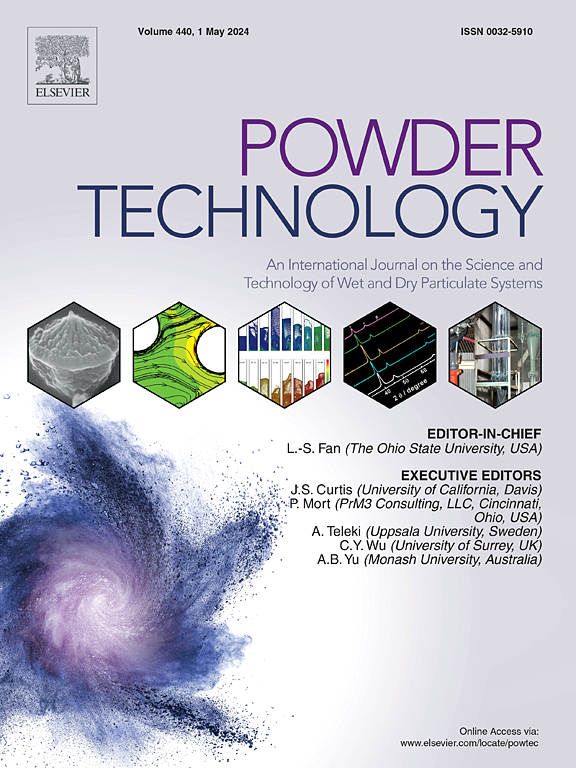Effect of active material morphology on PTFE-fibrillation, powder characteristics and electrode properties in dry electrode coating processes
IF 4.5
2区 工程技术
Q2 ENGINEERING, CHEMICAL
引用次数: 0
Abstract
This study investigates the significant impact of different active material particle morphologies – platelet-like graphite, spherical highly porous LFP, and spherical NCM – on PTFE fibrillation during mixing and calendering steps of a dry coating process. Graphite's platelet-like structure slows PTFE fibrillation compared to LFP's structure, which exhibits prolonged PTFE fibrillation due to its fine particle content. NCM, with higher density and compaction speed, promotes faster PTFE fibrillation during mixing. The hierarchical morphology of the fibrils determines the powder blend properties. Consequently, powder behaviour in the calender gap was characterised using uniaxial compression and ring shear cell tests. Uniaxial compression tests revealed that NCM-based powder requires higher compression stress. Under consistent calendering conditions, it forms thicker dry-coated films compared to the graphite-based powder, which requires lower compression stress and forms thinner films. These findings are supported by ring shear cell tests, which showed lower wall friction for graphite-based powder and a higher wall friction angle for NCM-based powder. Additionally, the porosity of the free-standing films can be predicted using uniaxial compression tests. These results highlight the need for tailored mixing and calendering processes for each active material to optimize electrode properties in dry coating processes for lithium-ion batteries.

干电极涂层工艺中活性材料形态对聚四氟乙烯纤维化、粉末特性和电极性能的影响
本研究调查了不同活性材料颗粒形态--血小板状石墨、球形高孔隙 LFP 和球形 NCM--在干涂层工艺的混合和压延步骤中对 PTFE 纤维化的重大影响。与 LFP 的结构相比,石墨的血小板状结构可减缓 PTFE 纤维化,而 LFP 的细颗粒含量则可延长 PTFE 纤维化。NCM 具有更高的密度和压实速度,可在混合过程中更快地促进 PTFE 纤维化。纤维的分层形态决定了粉末混合物的特性。因此,使用单轴压缩和环形剪切单元测试对粉末在压延机间隙中的行为进行了表征。单轴压缩试验表明,基于 NCM 的粉末需要更高的压缩应力。在一致的压延条件下,它能形成较厚的干涂层膜,而石墨基粉末则需要较低的压缩应力,并能形成较薄的膜。环形剪切池测试证实了这些发现,测试结果表明石墨基粉末的壁面摩擦力较小,而 NCM 基粉末的壁面摩擦角较大。此外,利用单轴压缩测试还可以预测独立薄膜的孔隙率。这些结果突出表明,需要为每种活性材料量身定制混合和压延工艺,以优化锂离子电池干涂层工艺中的电极特性。
本文章由计算机程序翻译,如有差异,请以英文原文为准。
求助全文
约1分钟内获得全文
求助全文
来源期刊

Powder Technology
工程技术-工程:化工
CiteScore
9.90
自引率
15.40%
发文量
1047
审稿时长
46 days
期刊介绍:
Powder Technology is an International Journal on the Science and Technology of Wet and Dry Particulate Systems. Powder Technology publishes papers on all aspects of the formation of particles and their characterisation and on the study of systems containing particulate solids. No limitation is imposed on the size of the particles, which may range from nanometre scale, as in pigments or aerosols, to that of mined or quarried materials. The following list of topics is not intended to be comprehensive, but rather to indicate typical subjects which fall within the scope of the journal's interests:
Formation and synthesis of particles by precipitation and other methods.
Modification of particles by agglomeration, coating, comminution and attrition.
Characterisation of the size, shape, surface area, pore structure and strength of particles and agglomerates (including the origins and effects of inter particle forces).
Packing, failure, flow and permeability of assemblies of particles.
Particle-particle interactions and suspension rheology.
Handling and processing operations such as slurry flow, fluidization, pneumatic conveying.
Interactions between particles and their environment, including delivery of particulate products to the body.
Applications of particle technology in production of pharmaceuticals, chemicals, foods, pigments, structural, and functional materials and in environmental and energy related matters.
For materials-oriented contributions we are looking for articles revealing the effect of particle/powder characteristics (size, morphology and composition, in that order) on material performance or functionality and, ideally, comparison to any industrial standard.
 求助内容:
求助内容: 应助结果提醒方式:
应助结果提醒方式:


